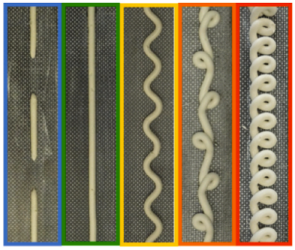
Printing by Yield-Stress Fluid Shaping
- Post by: olivier.pitois
- 29 novembre 2023
- No Comment
3D printing of yield stress fluids (i.e., materials able to flow like liquids only beyond a critical stress) is opening new doors in the fields of construction, food or medicine. The usual printing technique consists to extrude and then deposit a filament of yield stress fluid onto the previous layer. One major difficulty is that, during the deposition process, some instabilities may appear and have a catastrophic impact on the final 3D structure. Here we show that these instabilities can be predicted as a function of the material properties and/or the printing parameters. More generally, we study the deposit of a filament from systematic tests with a model yield stress fluid, varying the material yield stress value, the distance between the nozzle and the substrate, the extrusion velocity, the nozzle diameter, and the nozzle displacement velocity. We show that a diversity of patterns arises: drops, discontinuous lines, straight lines, meanders, alternated loops or translated loops. Then, we demonstrate that the transitions (frontier curves) between pattern regions can be predicted by theoretical arguments. Finally, we present a generic diagram predicting the patterns observed as a function of dimensionless numbers depending on the various characteristics of the system. This provides a reference scheme for optimizing practical processes or devising specific deposit patterns, valid for a wide range of conditions and yield stress fluids.
https://www.sciencedirect.com/science/article/pii/S2214860423003652

